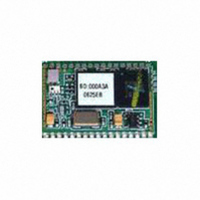RN-21 Roving Networks Inc, RN-21 Datasheet - Page 6

RN-21
Manufacturer Part Number
RN-21
Description
MODULE BLUETOOTH 2.0/EDR CLASS1
Manufacturer
Roving Networks Inc
Specifications of RN-21
Frequency
2.4GHz
Data Rate - Maximum
921kBaud
Modulation Or Protocol
Bluetooth v2.0+EDR, Class 1 & 2
Applications
Bluetooth v2.0
Power - Output
15dBm
Sensitivity
-80dBm
Voltage - Supply
3 V ~ 3.6 V
Current - Receiving
35mA
Current - Transmitting
65mA
Data Interface
PCB, Surface Mount
Memory Size
8MB Flash
Antenna Connector
PCB, Surface Mount
Operating Temperature
-40°C ~ 85°C
Package / Case
Module
Wireless Frequency
2.402 GHz to 2.48 GHz
Interface Type
USB, UART, PCM
Data Rate
921.6 Kbps
Modulation
FHSS
Operating Voltage
3.3 VDC
Antenna
Chip
Board Size
21.8 mm x 12.5 mm x 2 mm
Operating Temperature Range
- 40 C to + 85 C
Security
128 bit Encryption
Lead Free Status / RoHS Status
Lead free / RoHS Compliant
Lead Free Status / RoHS Status
Lead free / RoHS Compliant, Lead free / RoHS Compliant
Other names
740-1006
Ordering Information
Visit
Networks Products.
The Bluetooth trademark and logo are registered trademarks of Bluetooth SIG, Inc. All other trademarks are
property of their respective owners.
Roving Networks reserves the right to make corrections, modifications, and other changes to its products,
documentation and services at any time. Customers should obtain the latest relevant information before
placing orders and should verify that such information is current and complete.
Roving Networks assumes no liability for applications assistance or customer’s product design. Customers are
responsible for their products and applications which use Roving Networks components. To minimize
customer product risks, customers should provide adequate design and operating safeguards.
Roving Networks products are not authorized for use in safety-critical applications (such as life support) where
a failure of the Roving Networks product would reasonably be expected to cause severe personal injury or
death, unless officers of the parties have executed an agreement specifically governing such use.
5. Using SPI bus for flash upgrade. While not required, this bus is very useful for configuring advanced
6. Antenna Design. The pattern from the rf_out terminal pad should be
7. Soldering Reflow Profile.
parameters of the Bluetooth modules, and is required for upgrading the firmware on modules. The
suggested ref-design shows a 6pin header which can be implemented to gain access to this bus. A
minimum-mode version could just use the SPI signals (4pins) and pickup ground and VCC from elsewhere
on the design.
designed with 50ohms impedance and traced with straight lines. (see
diagram to the right) The rf_out signal line should not run under of near the
RN21 module. The GND plane should be on the side of the PCB which the
module is mounted. The GND should be reinforced with through-hole
connections and other means to stabilize the electric potential.
Recommended on-chip antenna is Yageo SMT high performance chip for
Bluetooth/802.11b/g 2.45GHz (3.6mm x 7.2mm)
Part Number
http://www.rovingnetworks.com
•
•
•
•
809 University Avenue
RN-21-H
RN-21-U
RN-21
Lead-Free Solder Reflow
Temp: 230 degree C, 30-40 seconds, Peak 250 degree C maximum.
Preheat temp: 165 +- 15 degree C, 90 to 120 seconds.
Time: Single Pass, One Time
For other configurations, contact Roving Networks directly.
Standard firmware (SPP/DUN Master and Slave)
HCI firmware (HCI over H4 UART)
USB firmware (HCI over USB port, slave device at 12Mbps rate)
Copyright © 2009 Roving Networks. All rights reserved.
•
Los Gatos, CA 95032
for current pricing and a list of locations selling Roving
•
Description
Tel (408) 395-6539
• info@RovingNetworks.com
DS-RN21-V2 3/25/2010
RN21 Module
RN21 Module
RF_OUT
RF_OUT
GND
GND
GND
GND

















